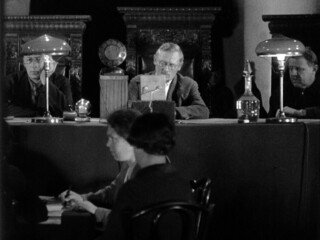At the ICA
Anna Aslanyan
On a cold evening in late 1930, hundreds of people march outside Moscow’s House of the Unions, shouting slogans and carrying banners: ‘Death to the saboteurs!’; ‘Down with Poincaré! Long live the Red Army!’ Inside, in the packed hall, the Industrial Party Trial is in progress. It begins with all eight defendants pleading guilty to their crimes – industrial sabotage; conspiracy to restore capitalism in the USSR in collusion with imperialist powers – and ends 13 days later with five of the engineers being sentenced to death and the rest sent to prison.
Sergei Loznitsa’s film The Trial, released last year and shown at the ICA last week, is composed from the original footage of one the first Stalinist show trials. The only additions are intertitles, which reveal at the end, for anyone who didn’t already know, that the ‘Industrial Party’ never existed. Some of the footage was used in a 1931 propaganda film directed by Yakov Poselsky (and, as Loznitsa joked in his introduction at the ICA, by Joseph Stalin). A team of investigators worked on producing the show trial for more than a year, drafting the script and coaching the actors. It isn’t clear if the public filling the hall are aware of their role: some listen to the proceedings intently, others fall asleep, some take notes, others shield their eyes when the lights are on them.
The footage is a milestone in the history of cinema as well as of totalitarianism. It’s an early example of sound and image being recorded simultaneously. Loznitsa described the way they cleaned the film, and of the importance of sound in his other documentaries. Some of them – The Event, about the failed 1991 coup that led to the collapse of the Soviet Union; Austerlitz, about Holocaust tourism; Victory Day, about the Russians who gather in Berlin to commemorate the USSR’s victory over the Third Reich – are being shown in London as part of a mini-retrospective of his work (until 18 September). His other films include Maidan, about the 2014 uprising in Ukraine.
The 1930 show trial was, in Loznitsa’s words, ‘designed to solve political problems by means of theatre’. Unlike earlier attempts, when the participants refused to collaborate, the Industrial Party Trial was a success. Everyone’s acting is certainly impressive. The engineers and the judges flaunt their rhetoric, their accents betraying their pre-revolutionary education: ‘I offer my deep repentance,’ says the lead defendant, Leonid Ramzin, ‘and cease fighting against the Soviet power for good.’ There are dramatic cadences, sniffles and scientific metaphors: at one point, the saboteurs are compared to Archimedes and their alleged French accomplices to a fulcrum.
The closing titles summarise the fate of the defendants. Their death sentences were commuted (did they know they would be when they stoically listened to the verdict?); some of them returned to work after prison; Ramzin was pardoned in 1936 and awarded the Stalin Prize in 1943 for his achievements in the energy industry. The state prosecutor, Nikolai Krylenko, was meanwhile arrested for anti-Soviet activities and executed in 1938. The summary hearing took 20 minutes. His scene was subsequently cut from Poselsky’s documentary.
The orchestrators of the case had a number of goals in mind: to strengthen their power, to blame industrial failures on the class enemy and, ultimately, to destroy the old intelligentsia. It was also a dress rehearsal for the Great Purges. Someone in the audience asked Loznista why no one spoke out against the falsifications in 1930, when it was still relatively safe. Totalitarian oppression is a gradual process, he replied, imperceptible until everyone is complicit in it. He quoted the Ukrainian film director Oleg Sentsov, recently freed in a prisoner exchange between Russia and Ukraine, who said that the worst thing about the ongoing war between the two countries is the Russian public’s support for it.
A few years before the Industrial Party Trial, the Left Front of the Arts responded to revolutionary demands by introducing a new genre, ‘factography’, in literature and film. Grounded in real-life events (as against the bourgeois notion of fiction), this practice, in the words of its main proponent Sergei Tretyakov, involved documentation but also ‘operativity’, aiming not so much at reflecting reality as at transforming it. The Trial, too, has an avant-garde feel. Krylenko – he brandishes a book throughout his fiery speech, and at the end throws it down with a flourish – looks like Mayakovsky giving a public performance. Another avant-garde film-maker of the era, Dziga Vertov, also comes to mind: he defined cinema as ‘the factory of facts’.
